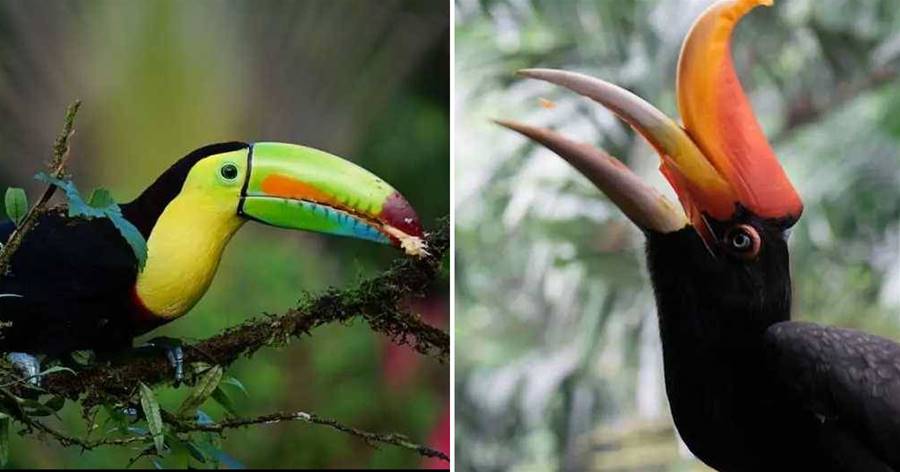

The beak is, arguably, the most important and distinctive aspect of a bird. It’s necessary for eating, preening, defense, and even mating displays, and plays a large role in how the bird interacts with their environment. Beaks come in all shapes and sizes. Some birds have short beaks, some have long. Other birds have tiny beaks, while some like you’ll soon see, have quite large beaks. In this article we’re going to look at some examples of birds with big beaks.
Birds with big bills have evolved throughout the world for a long time, carving out niche roles in their ecosystems that they must stick to.
They are an integral part of their ecosystems.Here’s a list of 19 birds with big beaks, and their pictures, to help you better understand just how unique they are.

Scientific name:
Length: 43-60 inches
Beak Length: 7.4-9.4 inches
The Shoebill is also known as the whalehead or whale-headed stork for its enormous, shoe-shaped bill. It has a somewhat stork-like form and has been previously classified as such, but they’re closer genetically to pelicans and other large, four-toed birds.
The Shoebill lives in tropical east Africa in large swamps from South Sudan to Zambia. Their upper mandible is strongly keeled and ends in a sharp nail that can be used for self-defense.
Overall, they’re noted for their slow movements and their tendency to stay still for long periods of time. They’re also known for their bill-clattering displays they do around their nest or when greeting another bird. This prehistoric looking bird definitely has one of the biggest beaks around. It’s probably the bird I think of first when it comes to birds with big beaks.
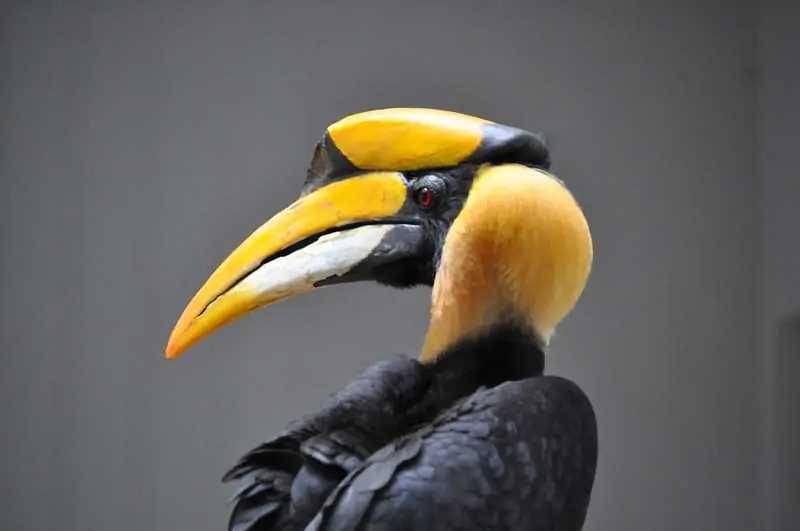
Scientific name:
Length: 3.1-3.9 feet
Beak Length: 9-10 inches
The Great Hornbill is found in mainland Southeast Asia, the Malay Peninsula, and Indonesia, and are breeding residents throughout the Asian continent. They’re arboreal birds, preferring to live in wet, tall, evergreen forests filled with old-growth trees perfect for nesting.
They’re a very distinctive and vividly colored bird that has a special preen gland that secretes tinted oil that’s spread across the feathers by the bird during grooming. They also have a large casque, which is a hollow structure located on top of the bill used by males to fight with other males and attract females.

Scientific name:
Length: 37-41 inches
Beak Length: 9.2-12 inches
When it comes to birds with big beaks, we couldn’t neglect mentioning the Rhinoceros Hornbill. Similar to the Great Hornbill and other birds in that family, it has a prominent casque on the top of its beak. It’s made of keratin and acts as a resonating chamber, amplifying the birds calls to be heard throughout the Indonesian rainforests they call home.
They feed mostly on fruits and insects, but have been known to prey on small reptiles, rodents, and smaller birds as well. They also form a very unique nest when taking care of their young – the female is actually sealed inside a nest in a hollow tree with only a small hole for the male to pass food through.
This ensures a high survival rate for their young, but becomes a threat if the male is injured or otherwise unable to return – usually due to human intervention.

Scientific name:
Length: 4.2-5.4 feet
Beak Length: 10-14 inches
The American White Pelican is one of the largest North American birds with a wingspan of nearly 9 feet. They soar with incredible steadiness on broad, white and black wings. Their large pouched bills are used to scoop up fish.
They’ve been known to cooperate with one another to herd fish into the shallows to make for easy feeding and can be found on inland lakes in the summer and near the coastlines in the winter.
Contrary to common misconceptions, the American White Pelican never carries food inside of their bill pouch.
It’s only used to scoop up the food, but their catch gets swallowed before takeoff. They’re also skillful food thieves and are successful at stealing from other pelicans about one-third of the time.
Scientific name:
Length: 5-6 feet
Beak Length: 14-18 inches
The Dalmatian Pelican is the largest of the pelican species and is among the largest birds still alive today. It’s also one of the heaviest of flying birds with a wingspan of nearly 11 feet.
It features stunning silvery-white plumage during the season, and then fades to a less shiny white or gray the rest of the year.They’re very social birds, preferring to live and travel in flocks. They may not be especially graceful on land, but they’re powerful swimmers and strong fliers as well. They spend the majority of their time using their beak, which like all pelicans is used to scoop up their food, to groom themselves and distribute waterproofing oil throughout their feathers.

Scientific name:
Length: 25 inches
Beak Length: 7.5 inches
The Toco Toucan is the largest and best-known toucan species as well as one of the most famous of all birds with big beaks. It makes its home in South America’s tropical forests – indigenous peoples regard it as a conduit between the worlds of the living and the spirits, and its no wonder that its captured the imagination of humans throughout time with its large and colorful beak.
Their beak makes for a poor weapon, as it’s more for show than anything else. It’s made of a fragile honeycomb of keratin and is used more as a deterrent against predators.
Its bill is also used to regulate its body heat by changing the flow of blood to it in order to distribute heat away from their body.
Scientific name:
Length: 5.2-6.2 feet
Beak Length: 15-17 inches
The Australian Pelican has been recorded as having the longest bill of any living bird. It’s a unique color with a pink bill and white plumage and black-tipped wings. It mainly eats fish, but will also consume smaller birds and scavenge for scraps to supplement their diet.
They span large expanses of mainland Australia and Tasmania, usually over large areas of open water without dense aquatic vegetation. They’ve also been known to habituate flooded areas following heavy rain and any other area of water that can support a sufficient supply of food for them to scoop up with their bill.

Scientific name:
Length: 5.5 inches
Beak Length: 4 inches
The Sword-Billed Hummingbird is one of the largest species of hummingbird and boasts the largest ratio of body to beak size of any bird.
Their extremely elongated bill and equally long tongue allow them to feed on flowers with long corollas.They’re solitary in all aspects of life other than breeding, and the male doesn’t even play a role in his children’s lives past the actual mating with the female. The female chooses the nest location, the material to use, and is in charge of raising the chicks as well.

Scientific name:
Length: 34-39 inches
The Southern Giant Petrel is famous for its amazing flying strength and endurance. They have a distinctive salt gland that lies atop their thick hooked bill that acts as a way to excrete excess salt. They’re known as the vultures of the sea for their scavenging preferences.
When scavenging options are slim, they’ll use the hook on their beak to capture and eat squid, fish, young penguins, and other seabirds. They’re the largest petrel species and their heavy bills are “clacked” together to make noise for courtship displays.

Scientific name:
Length: 47-60 inches
Beak Length: 9.4 inches
The Goliath Heron is the largest living heron in the world. It’s highly aquatic and rarely ventures far from a water source – it prefers to fly along waterways rather than move over land. It’s typically found in shallow water hunting, but has been observed near deep water over dense vegetation as well.
They’re solitary foragers and are highly territorial towards other herons. Their prey consists almost entirely of relatively large fish, only catching around 2 or 3 a day. They also use their long and sharp bill to eat other small animals they may come across, including frogs, lizards, and snakes.

Scientific name:
Length: 20-26 inches
Beak Length: 4.4-8.6 inches
The Long-Billed Curlew is America’s longest shorebird. It uses its long curved bill to probe deep in the mud and sand while looking for aquatic invertebrates to eat. It can also be used effectively to find grasshoppers in their breeding grounds of the grasslands of the American Great Plains and protects many crops from these pests.
They spend the majority of the winter in wetlands, tidal estuaries, mudflats, flooded fields, and beaches.
It has an unmistakable silhouette – simply look for a long neck and long bill strutting through the grasslands. They’re often accompanied by smaller groups of other foraging shorebirds, including Willets and Marbled Godwits.
Scientific name:
Length: 28-32 inches
Beak Length: 4-6 inches
The Roseate Spoonbill is locally common in coastal Florida, Texas, and southwest Louisiana. They prefer to wander in small flocks and will often associate with other waders.
Spoonbills feed in shallow waters and use their wide flat bills to sift the muck by swinging their head from side to side.This gorgeous bird is uncommon and incredibly vulnerable to degradation of feeding and nesting habitats. They were virtually eliminated from the United States as a side-effect of the destruction of wader colonies by plume hunters in the 1860s, and only recently began to re-colonize Texas and Florida in the 20th century.
Most definitely one of the most unique looking birds with big beaks.
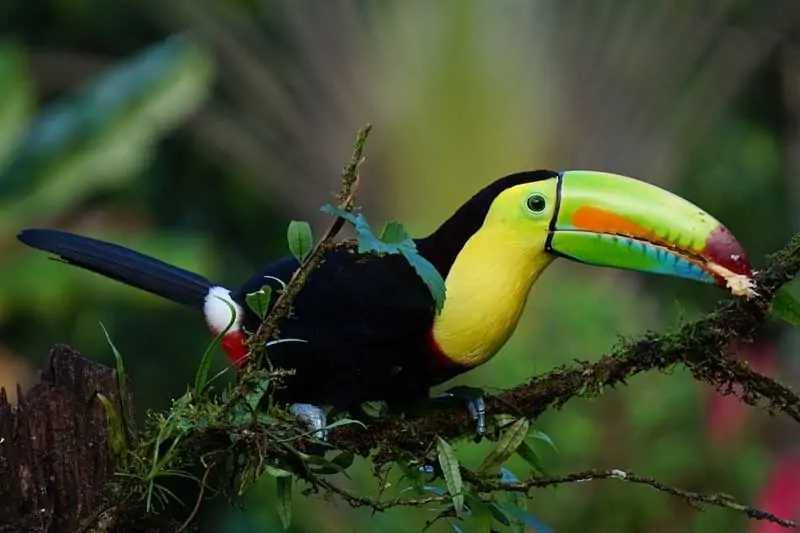
Scientific name:
Length: 19-20 inches
Beak Length: 6-8 inches
Along with the Toco Toucan, the Keel-Billed Toucan may be one of the most instantly recognizable species of birds with big beaks in the world. They’re primarily fruit eaters throughout South and Central America, but will occasionally eat insects, reptiles, other birds, and eggs to supplement their diet.
Their large beak may look large and heavy, but it’s actually incredibly light. It’s made of keratin and is hollow with only thin rods of bone for support. It’s currently unknown the specific reason for their gigantic bill, but scientists believe it plays an important role in courtship displays and for defense.

Scientific name:
Length: 3.3-3.8 feet
Beak Length: 5-8 inches
White storks inhabit open wetlands, savannas, steppes, meadows, pastures, and agricultural fields throughout Europe, North Africa, Asia Minor, and the Middle East. They like areas with shallow standing water and are well adapted to human presence in their habitat.
They eat a wide variety of prey that includes insects, scorpions, spiders, frogs, tadpoles, fish, lizards, snakes, crustaceans, small mammals, and eggs of ground-nesting birds.
Foraging White Storks visually search for food while walking with their bill pointed at the ground. When they detect prey, they jab their bill forward to grab and swallow whatever it is.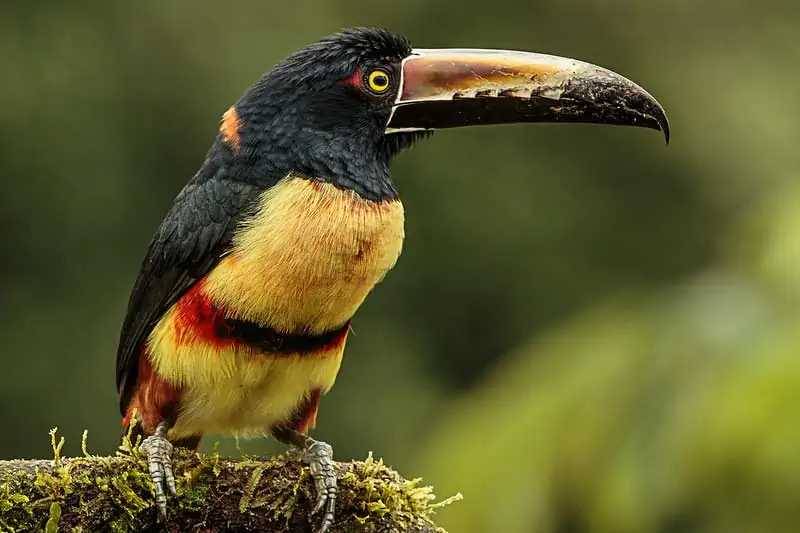
Scientific name:
Length: 16 inches
Beak Length: 4 inches
The Collared Aracari resembles a more muted toucan and is distantly related to the Toca Toucan. They’re native to Central America, ranging from southern Mexico to northern Colombia and are the most commonly encountered toucanet species in the region.
Their bill is made of honeycombed keratin just like a toucan’s, and they’re also quite fragile and mostly unusable for self-defense. It’s mostly used to reach fruits that are on branches that are too thin and flimsy to support their full weight.

Scientific name:
Length: 15-19 inches
Beak Length: 4-5 inches
The Whimbrel is a relatively large bird with a fragile, long, curving beak. They occupy open habitats – tundra for nesting and mudflats, beaches, and saltmarshes the rest of the year.
Whimbrels use their enormous bills to extract crabs and other marine invertebrates from the sand or mud.They may appear delicate, but these birds are strong migrators, going between arctic nesting areas and wintering grounds as far south as Bolivia. They even have to occasionally skirt hurricanes as they fly over the open ocean.

Scientific name:
Length: 19-24 inches
Beak Length: 3.5-5 inches
The Southern Yellow-Billed Horntail has been made famous by the movie The Lion King – the main bird character Zazu is a Yellow-Billed Horntail. They have a wide-ranged omnivorous diet consisting of insects, bird chicks, frogs, chameleons, ants, and termites.
Their beak is a vibrant yellow, earning them the affectionate nickname of “flying banana”. The female’s bill is shorter than that of the male, and like all hornbills, contain a casque used to amplify their voice across the African savannah. They forage cooperatively with mongoose, waiting for them to drive out prey from underground and leaving some behind for the small mammals.

Scientific name:
Length: 16-20 inches
Beak Length: 3-4 inches
The Black Skimmer is a species of seabirds similar to gulls. Their beak is their most distinctive feature – it’s incredibly sharp with the lower mandible protruding against the upper half of the beak. This is used for hunting their prey by grazing the lower half of their beak against the surface of the water, thereby catching fish and other organisms in their mouths.
Another instantly noticeable feature of the Black Skimmer is its distinctly red feet that match their bright red-orange bill with a black tip. They’re also unique in that they have a large pupil with a vertical slit, which is rare in birds. This is to cut down on the glare of the sand and water.

Scientific name:
Length: 18-20 inches
Beak Length: 3.5-4.7 inches
The Great Spotted Kiwi is a small, flightless, and nearly wingless bird about the size of a chicken that’s only found in New Zealand.
It’s part of the same family as the cassowary, emu, and ostrich – all flightless birds lacking a special ridge on their sternum where flight muscles attach.Despite its small size and awkward appearance, the kiwi is able to outrun a human and is quite wary around anything larger than themselves. The Kiwi is also quite dense, with bones that contain marrow, and this makes it difficult to nest in trees.
To make up for this, the kiwi digs burrows instead of building a nest and has modified feathers that serve as whiskers on their face and around the base of their beak.


















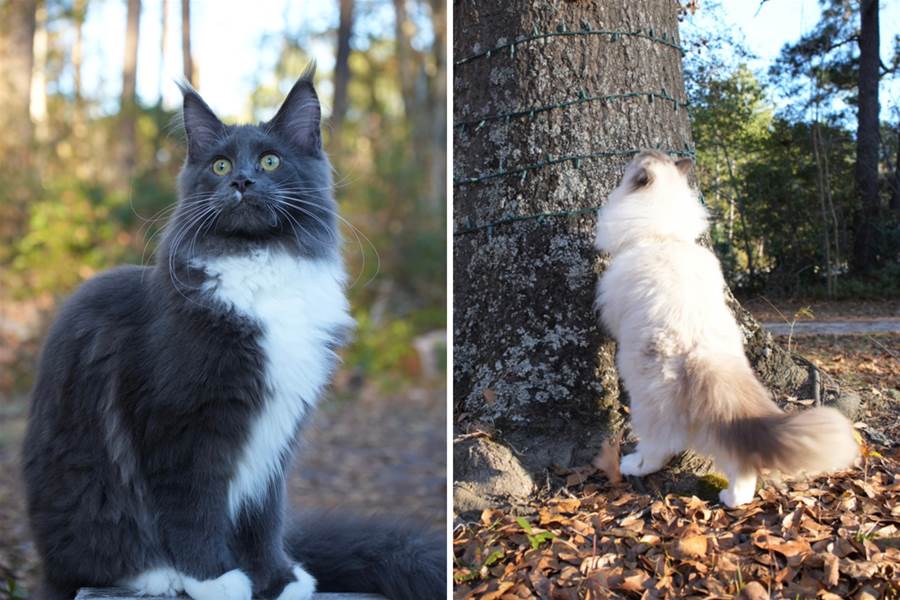

代表者: 土屋千冬
郵便番号:114-0001
住所:東京都北区東十条3丁目16番4号
資本金:2,000,000円
設立日:2023年03月07日
